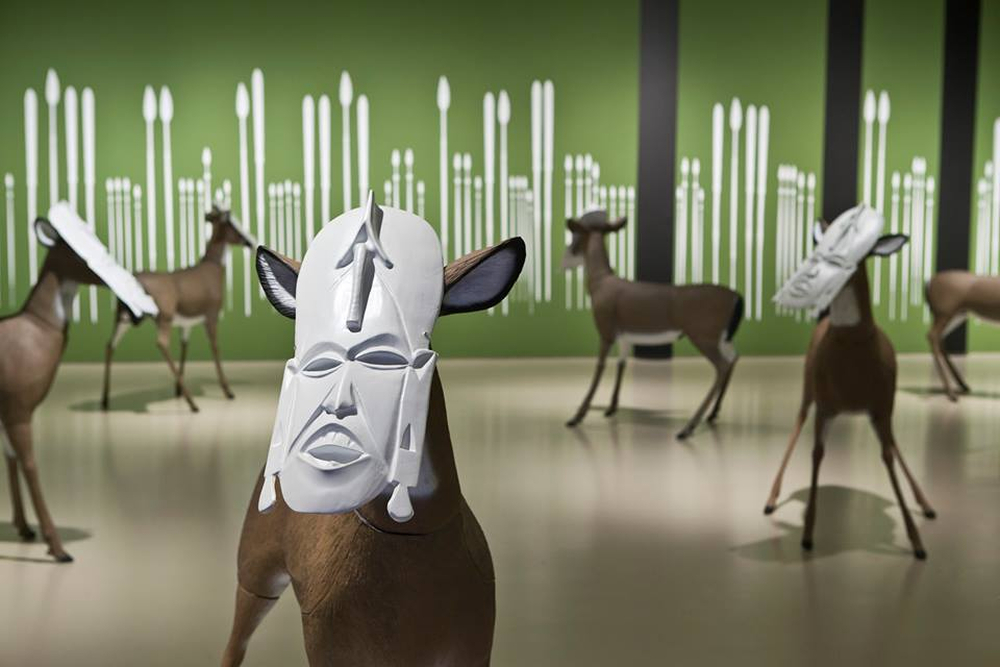“This debt we pay to human guile; with torn and bleeding hearts we smile,” wrote African-American poet Paul Dunbar in his 1896 poem, We Wear the Mask. About 100 years later the Fugees rapped, “Put the mask upon the face just to make the next day/ Feds be hawkin me, jokers be stalking me/ I walk the streets and camouflage my identity.”
In both works, a mask is suggested to confront the indignity and oppression suffered on a daily basis in an unjust society.
But then there’s the testament of a woman in Nigeria, who participated in a masquerade as part of artist Wura-Natasha Ogunji ‘s video experiments on the transformative power of African masks: “Oh my God, it’s amazing! People moved out of my way. I could stand there and nobody was going to do anything to me or ask me for anything. I could move freely through space.”
In a parallel pursuit, fellow Nigerian artist/journalist Zina Saro-Wiwa sought a more personal form of catharsis after the execution of her father, author and environmentalist and human rights activist Ken Saro-Wiwa at the hands of military dictator General Sani Abacha in 1995 . Ogunji and Saro-Wiwa are just two of the 12 artists featured in Disguise: Masks and Global African Art at UCLA’s Fowler Museum .
Originating in Seattle and stopping in Los Angeles on its way to the Brooklyn Museum in April, the new show looks at an ancient form through the eyes of contemporary African artists, and those of African descent, working in sculpture, photography, installation art, street action, computers and virtual reality to explore issues ranging from self-realisation to cultural and political transformation.
“While they’re all looking at the general field of African masquerade, they’ve found different elements to draw out of it,” says the Fowler’s Erica Jones. The wide-ranging show runs from Saya Woolfolk ‘s imaginary culture of the Empathic – a psychedelic sculpture, paint and performance installation blending African influences with an array of flavours east and west of the continent – to artist Nandipha Mntambo in her suit of lights made from cowhide, caping a bull in an abandoned plaza de toros.
“It illustrates how vibrant masquerade is as a tradition, how malleable it is. That it’s something that’s been around for thousands of years is a testament to what an adaptable art form it is.”
Masquerade’s healing powers
Masking varies from culture to culture, even in a country as populous as Nigeria, home to traditions as varied as the Edo in the north and Yoruba in the south. The spiritual underpinning of many communities, it usually involves song, dance or acting out ethical quandaries and issues related to the divine world. In disguises ranging from carved masks to head-to-toe costumes, the spirit world opens to the masquerader and he becomes the divinity whom he invokes. The key word is “he”, since it is a tradition that remains almost exclusively male-dominated, even when calling on female spirits.

Brendan Fernandes’s Neo Primitivism 2. (Facebook/Fowler Museum)
Catharsis came on a more personal level for Saro-Wiwa, who returned to her Niger Delta homeland of Ogoniland in 2014 after nearly 20 years in exile following her father’s execution. The journey opened new doors for the artist when she encountered Ogele, a more recent form of masquerade which began in the late 1980s. One of the masks bore the likeness of her father, which drew her deeper into masquerade’s healing powers. She first suggested to the women of the Ogoni that they should have their own masquerade troupe, and they heartily embraced the idea. Then she commissioned her own mask with which to confront the “invisible man” that seemed to follow her around, a spirit of her tragic familial past.
“For Zina and for Wara, I don’t think they set out to appropriate the mask. This was something like an evolution that led them to this,” says Jones, an American-born half-Nigerian, who splits her time between Texas and Lagos. “As a Yoruba woman she wants to learn about her own culture and became really interested in Egungun and these mask ancestors. That’s what led to her wanting to engage in masquerade culture for women.”
For her 2013 video, An Ancestor Takes a Photograph, Ogunji filmed a half-dozen or so women in Egungun dress, which covered them from head to toe. Amid the shoppers at a busy Lagos market, there was no way of knowing they were women. It is considered taboo for masqueraders to address others, so no one asked. But there were suspicions.
A vehicle for dissent
“When you’re in this costume, you can move through the streets and people move out of your way,” says Ogunji. “There’s a deep sense of respect, and you can negotiate the streets, you can negotiate spaces in a way that women don’t experience on a daily basis.”
According to the Kebetkache Women Development and Resource Center in the embattled Niger Delta, a proliferation of guns and gangs have signalled a sharp rise in violence against women in the area. Further to the north, terrorist groups like Boko Haram have become famous for preying on women. Even in Lagos, where women live free of such violence, there are no official channels to challenge a patriarchy that routinely denies them their rights. And so masquerade has emerged as a vehicle for dissent.
“It is really logical that this is a time that women would look at masquerade and say if this is something that men could use for gaining and maintaining power, we want access,” says Jones about the status-raising power of the ritual. “The reason it has remained so vital for so long is that it is a great form for people to push the boundaries and make statements about how they feel their culture needs to change.” – (c) Guardian News & Media Ltd, 2015
Disguise: Masks and Global African Art is at UCLA’s Fowler Museum until 13 March.